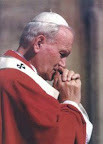Love of Liturgy and Liturgy of Love
 Many people had been waiting, with either great hope or great anxiety, the document that was finally issued by the Holy Father last Saturday. Summorum Pontificum greatly relaxed, effective September 14, the restrictions that have for some time been in place on the use of the Tridentine liturgy. The Tridentine liturgy is often mistakenly refered to as the Latin Mass, but that is a misnomer. The New Order of the Mass (called the Mass of Paul VI) was also written in Latin, as most international church documents are. In 1963 the Second Vatican Council had given permission for certain parts of the Mass to be translated into the spoken language of the local congregation. Directives issued together with and after the two revisions of the Mass of Paul VI (in 1969 and 1971) expanded that permission. Those directives were carried out with respect to the Mass of Paul VI, but not with respect to the Tridentine Mass since it had either fallen out of use or was supressed.
Many people had been waiting, with either great hope or great anxiety, the document that was finally issued by the Holy Father last Saturday. Summorum Pontificum greatly relaxed, effective September 14, the restrictions that have for some time been in place on the use of the Tridentine liturgy. The Tridentine liturgy is often mistakenly refered to as the Latin Mass, but that is a misnomer. The New Order of the Mass (called the Mass of Paul VI) was also written in Latin, as most international church documents are. In 1963 the Second Vatican Council had given permission for certain parts of the Mass to be translated into the spoken language of the local congregation. Directives issued together with and after the two revisions of the Mass of Paul VI (in 1969 and 1971) expanded that permission. Those directives were carried out with respect to the Mass of Paul VI, but not with respect to the Tridentine Mass since it had either fallen out of use or was supressed.
 Tridentine liturgy again. It is for us a symbol of reverence, prayerfulness, and transcendence. Many times we witness sloppiness or laziness at celebrations of the New Order of the Mass. It can be easy to forget that there were many occasions of such abuse at Mass before 1963, too. My great hope is that when mainstream Catholics walk into church one day and unexpectedly bump into a Tridentine liturgy, they will have an understanding for what is going on because of their experience with the vernacular liturgy. When they return to their more accustomed vernacular liturgy, it can be hoped that they will appreciate it more, too: its depth and mystery, often overlooked because of the New Mass's easy approachability. These two liturgies are really only two usages of, ways of doing, the Holy Sacrifice of the Mass. We can hope that with this understanding the Catholic Church, so full of every sort of diversity, will be enriched in a yet fuller way. The liturgy, Christ's saving work in our midst, is the undivided source of our love and unity with each other as baptized Christians. God forbid that having two liturgical usages at our disposal to celebrate the One Sacrifice of Jesus Christ should become a source of division.
Tridentine liturgy again. It is for us a symbol of reverence, prayerfulness, and transcendence. Many times we witness sloppiness or laziness at celebrations of the New Order of the Mass. It can be easy to forget that there were many occasions of such abuse at Mass before 1963, too. My great hope is that when mainstream Catholics walk into church one day and unexpectedly bump into a Tridentine liturgy, they will have an understanding for what is going on because of their experience with the vernacular liturgy. When they return to their more accustomed vernacular liturgy, it can be hoped that they will appreciate it more, too: its depth and mystery, often overlooked because of the New Mass's easy approachability. These two liturgies are really only two usages of, ways of doing, the Holy Sacrifice of the Mass. We can hope that with this understanding the Catholic Church, so full of every sort of diversity, will be enriched in a yet fuller way. The liturgy, Christ's saving work in our midst, is the undivided source of our love and unity with each other as baptized Christians. God forbid that having two liturgical usages at our disposal to celebrate the One Sacrifice of Jesus Christ should become a source of division.






















No comments:
Post a Comment